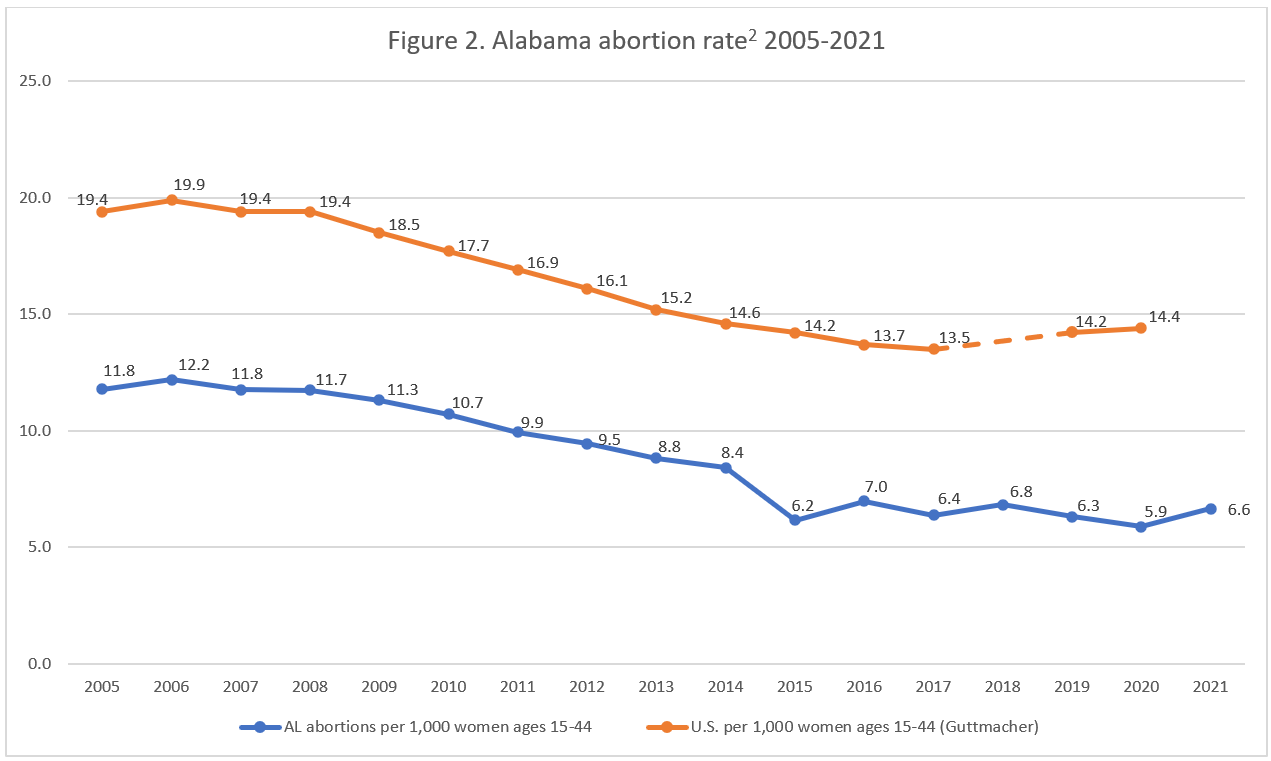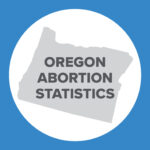Abortion Reporting: Alabama (2021)
Alabama’s 2021 abortion report was published online by the Alabama Department of Public Health in October 2022, showing that abortions reported in Alabama increased from 2020.
Statistics and Changes in Alabama Abortions, 2020-2021

Planned Parenthood’s abortion market share reflects all abortions reported in Alabama.
Abortion Totals and Trends
In 2021, there were 6,489 abortions reported in Alabama, up 14 percent from the previous year (Fig. 1). Chemical abortions rose markedly by 45 percent, composing 56 percent of the total. The Charlotte Lozier Institute (CLI) estimates that Alabama’s abortion rate increased by 13 percent to 6.6 abortions per 1,000 women ages 15 to 44 (Fig. 2). Alabama separately reports the number of abortions performed on state residents, both in Alabama and other states, although not all states share abortion data with Alabama. Abortions known to have been performed on Alabama residents increased by 11 percent from 7,466 in 2020 to 8,294 in 2021. As of December 2022, 26 states had released 2021 abortion statistics, with 18 reporting that abortions had increased from 2020.
State Report Summary
Abortions Performed on Alabama Residents
Eight percent of Alabama resident abortions were performed on girls under the age of 20; the youngest girl to undergo an abortion was 12. Thirty-one percent each were performed on women ages 20 to 24 and 25 to 29, while 27 percent of the abortion were obtained by women in their thirties. Three percent of the abortions were on women over the age of 40.
Over two-thirds of Alabama resident abortions, 67 percent, were performed on black women. Twenty-eight percent were obtained by white women, and three percent were on women of a different race. Race was not reported for one percent of the abortions. The black resident abortion rate, 18.6 abortions per 1,000 women ages 15 to 44, was five times higher than the white abortion rate of 3.7. A majority of the abortions, 91 percent, were performed on unmarried women, compared to seven percent on married and two percent on women of unknown marital status.
Just over a third of the abortions performed on Alabama residents (34 percent) were obtained by women with no previous live births. Twenty-eight percent were obtained by women with one prior live birth, and 38 percent were on women with two or more live births. The majority of the abortions (66 percent) were performed on Alabama women with no previous abortions. Twenty-two percent were on women with one prior abortion, and 12 percent were obtained by women with two or more previous induced abortions.
Under half the abortions, 42 percent, were performed on resident women who had completed at least some college. Forty-one percent were on women who had completed 12th grade as their highest level of education. Five percent were on women with an 11th grade education or less, and education was not reported for 12 percent of the abortions.
Twenty-nine percent of the abortions performed on Alabama women occurred at six weeks of gestation or earlier. Thirty-five percent were performed between seven and eight weeks gestation, dropping to 18 percent between nine and 10 weeks. Seven percent were performed between 11 and 12 weeks, while five percent each were performed between 13 and 14 weeks and 15 to 19 weeks. One percent (87 abortions) were performed at 20 weeks or later, with one being performed at 26 weeks or later. Because zero abortions were reported to have occurred in Alabama after 22 weeks post-fertilization (around 24 weeks of gestation), it is likely that this late-term abortion was performed on an Alabama resident in another state. At the time, abortion in Alabama was limited at 20 weeks post-fertilization (around 22 weeks of gestation) unless a woman’s life or major bodily function was at risk.
Abortions Performed in Alabama
Separately, Alabama reports on all abortions that occurred in the state, including those performed on both residents and nonresident women. There were 6,489 abortions reported in Alabama in 2021.
Nine percent of the abortions occurring in Alabama were performed on girls under the age of 20. Thirty-two percent were on women ages 20 to 24, and 30 percent were obtained by women ages 25 to 29. Twenty-seven percent were performed on women in their thirties, and three percent were performed on women ages 40 or older.
Alabama requires that parental consent be provided before an abortion is performed on a minor girl under the age of 18. In 2021, there were 177 abortions for which parental consent was required and one abortion on a minor for which it was not required because the girl was married. Parental consent was provided in 168 cases. In four cases a court order waived the consent requirement. For five of the abortions, it was not reported whether parental consent was obtained.
Just under two-thirds of the abortions, 64 percent, were performed on black women, even though black women compose just 31 percent of Alabama’s female population ages 15 to 44. Thirty-two percent of the abortions were obtained by white women, and four percent were obtained by women of other races. CLI estimates that Alabama’s black abortion rate for abortions occurring in Alabama was 13.9 abortions per 1,000 women ages 15 to 44, four times higher than the white rate of 3.3.
Thirty-six percent of the abortions reported in Alabama were conducted using suction curettage. Fifty-six percent were chemical abortions, and six percent were dilation and evacuation procedures. Two percent (124) were performed using electric vacuum aspiration. Three hysterectomies were performed, and a sharp curettage procedure was performed in two cases. There was one abortion performed via induction with an intraamniotic instillation and another one performed via induction of other means. The method of abortion was not reported in five cases. In four cases, an intra-fetal injection was used to kill the unborn baby.
Alabama reports all abortions occurring in the state using probable post-fertilization age, rather than gestational age, which it uses to report abortions performed on resident women. Post-fertilization age dates pregnancy from conception. In 2021, 59 percent of the abortions reported in the state occurred at six weeks post-fertilization or earlier. Twenty percent were performed between seven and eight weeks post-fertilization, and eight percent occurred between nine and 10 weeks. Five percent of the abortions were performed between 11 and 12 weeks post-fertilization, while three percent occurred between 13 and 14 weeks and four percent from 15 to 19 weeks post-fertilization. Two abortions were reported at 20 weeks post-fertilization or later, with one occurring at 20 weeks and one at 21 weeks. The report does not include the reasons why these two abortions were performed. Eleven abortions occurred at an unknown post-fertilization age.
Alabama Abortion Centers
In 2021, there were five operational abortion centers in Alabama – two operated by Planned Parenthood and three that were private offices. In 2021, the two Planned Parenthood locations accounted for 20 percent of the total number of abortions that occurred in Alabama. Planned Parenthood of Alabama in Birmingham performed 656 abortions and Planned Parenthood of Mobile, 615 abortions. The three private centers were responsible for the remaining 80 percent of abortions that occurred in Alabama in 2021. Alabama Women’s Center for Reproductive Alternatives performed 2,345 abortions (36 percent of the total), Reproductive Health Services of Montgomery performed 733 abortions (11 percent), and West Alabama Women’s Center performed 2,140 abortions (33 percent).
The Planned Parenthood center in Birmingham performed the two abortions that occurred at 20 weeks or later in Alabama. Two of the private centers, Alabama Women’s Center and West Alabama Women’s Center, performed 66 percent of the total number of chemical abortions that occurred in Alabama (3,653 abortions). Chemical abortion accounted for 80 percent of the total abortions that Planned Parenthood’s Birmingham center performed and all of the abortions that Planned Parenthood of Mobile performed.
Legislative Changes
When the United States Supreme Court overturned Roe v. Wade in June 2022, Alabama’s Human Life Protection Act (HB 314) became the law of the land in Alabama. This law prohibits abortion in all cases except in the cases where the life of the mother is in danger, or the unborn baby has a lethal fetal anomaly. HB 314 was enacted in 2019, but a legal challenge delayed the implementation of the law via a preliminary injunction. On the day that the Dobbs case was decided, the preliminary injunction was lifted and Alabama Attorney General Steve Marshall ordered that all abortion providers in the state “immediately cease and desist operations.”
State Ranking
In CLI’s 2016 review of abortion reporting across the 50 states, the District of Columbia, and New York City, Alabama was ranked at 12th best. To improve its reporting, as CLI has previously recommended, Alabama could report demographic information for all abortions occurring in the state. Additionally, Alabama could report the states to which Alabama residents travel for abortions, as well as the states of residence of nonresidents who obtain abortions in Alabama. Lastly, Alabama could also report abortion complication data, as the percentage of more dangerous chemical abortions continues to grow.


- The changes in total abortions and chemical abortions reflect all abortions reported in Alabama.
- Rates were calculated by CLI using the following formula: (total number of abortions performed in Alabama ÷ number of resident women ages 15-44) x 1,000. Rates may differ slightly from previous CLI articles due to revised population estimates. Rates reflect all abortions reported in Alabama. Population estimates were obtained from CDC WONDER. Estimates for 2005-2009 are intercensal estimates of the July 1 resident population. Estimates for 2010-2019 are Vintage 2020 postcensal estimates of the July 1 resident population. Estimates for 2020-2021 are Vintage 2021 postcensal estimates of the July 1 resident population. Estimates were produced by the U.S. Census Bureau and the National Center for Health Statistics.


























